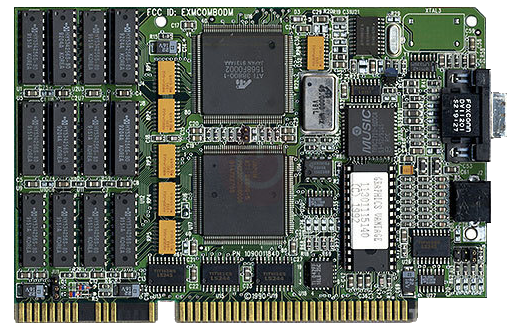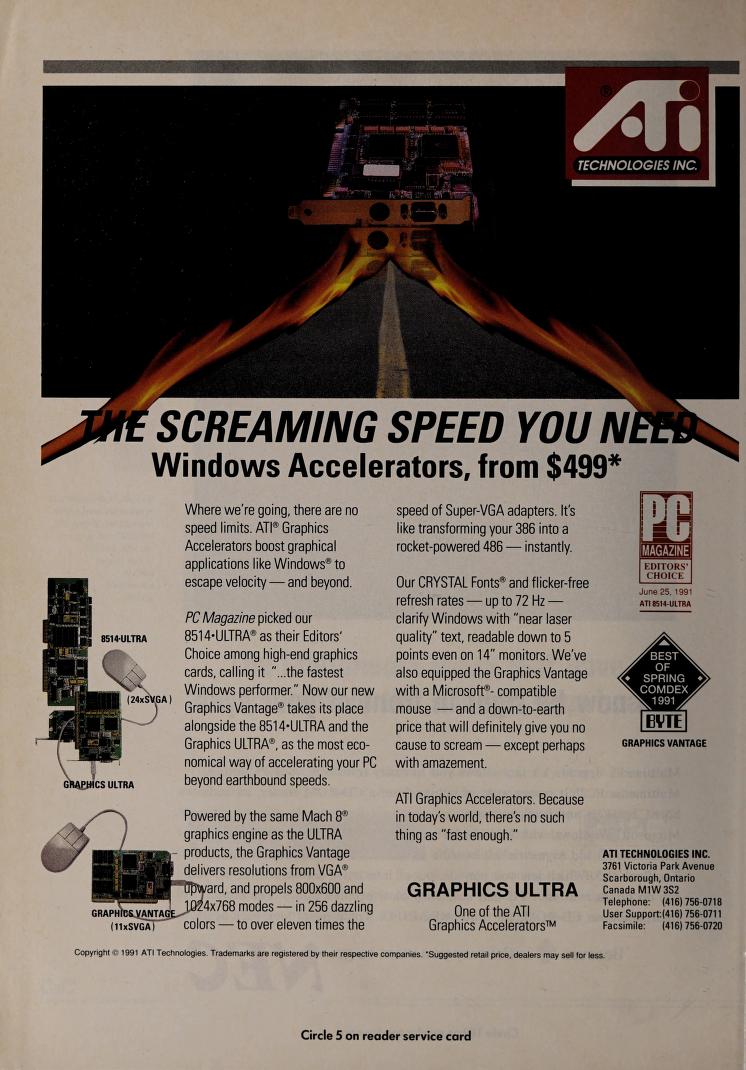ATI Graphics Vantage
The Graphics Vantage was a high-end graphics card by ATI, launched in January 1992. Based on the Mach8 graphics processor, it was identical to the Graphics Ultra, but used slower DRAM instead of the faster VRAM used on the Ultra.
 |
Released | January 1992 |
| Bus | ISA 16-bit | |
| Chipset | ATi Mach8 (38800-1) | |
| Standards | VGA and SVGA | |
| Memory | 1 MB DRAM (32-bit) | |
| Ports | 15-pin DSUB (RGB analogue) Bus mouse port |
|
| Part # | ||
| FCC ID | EXWC0MBODM | |
| Price | At launch: $599, Mar 1992: $499, Jun 1992: $349 | |
| See Also | Graphics Ultra, Graphics Vantage |
Both the Graphics Vantage and Graphics Ultra cards came with a bus mouse port and were bundled with a Microsoft 400-dot-per-inch bus mouse. Neither card came as standard with a Sierra HiColor DAC.
Its price at launch was $599 USD, and reduced to $499 on 1st March 1992. It was able to match its competitors such as the Diamond Stealth VRAM and Genoa WindowsVGA for speed.
For more information on the mach8 series of cards, see my dedicated page here.
Board Revisions
Competition
The Graphics Vantage competed directly with the Diamond Stealth VRAM and Genoa WindowsVGA.
In the Media
 "As expected, given their [Ultra and Vantage] identical VGA controller and amount of VGA RAM, the two ATI entries performed identically on PC Magazine Labs VGA Performance Tests - far faster than the S3-based entries overall. AutoCAD users will find that the ATI Mach 8 chip performs at generally middle-of-the-pack speed.
"As expected, given their [Ultra and Vantage] identical VGA controller and amount of VGA RAM, the two ATI entries performed identically on PC Magazine Labs VGA Performance Tests - far faster than the S3-based entries overall. AutoCAD users will find that the ATI Mach 8 chip performs at generally middle-of-the-pack speed.Under Microsoft Windows 3.0, results were more interesting. Across the board in 16-color mode, the Ultra and Vantage achieve performance indexes considerably lower than they are at 256 colors. An ATI spokesperson reports that the poor performance in 16-color mode is being remedied. Given that you must disable half the 1MB of memory on the Mach8 side to force the board to 16 colors under Windows and that performance in markedly better at 256 colors, however, seems moot: Leave the Vantage in 256-color mode under Windows and it will perform almost as well as its S3-based competition; leave the Ultra in 256-color mode and it will far surpass most of its S3-based competitors.
The allure of these boards only begins with speed, however. Given the boards' compatibility with the 8514/A at both the register- and applications-interface levels, you should have no problem convincing these controllers to run in accelerated modes with any remotely contemporary application. ATI also ships the board with a prime selection of drivers optimized for the Mach 8, including AutoCAD, CADkey, Lotus 1-2-3, Lotus Symphony, Ventura Publisher (GEM version), and Windows 3.0. OS/2 Presentation Manager drivers were due in January. Of course, the VGA side of the board maintains full VGA register-level compatibility.
The Ultra and Vantage are just as flexible when it comes to monitor refresh rates. Instead of allowing you one of only a few combinations across the available video modes, the ATI offerings come with a configuration utility that gives you a wide-ranging choice. Once you've specified the frequencies appropriate for your monitor, the utility writes these into EEPROM for future use. This task, as well as installation as a whole, is achieved without flipping so much as one DIP switch. ATI provides a menu-driven installation routine for provided applications drivers.
Those who have invested in a monitor capable of handling the VESA-recommended 72-Hz refresh rate should also appreciate the boards' ability to maintain it. (The ATI boards are not VBE-compatible, however). Unlike most of the competition, the Ultra and Vantage can drive the monitor at 72Hz across VGA, Super VGA and high-resolution modes without a proprietary driver. ATI claimed that it would support a 76-Hz refresh rate in 1,024-by-768 mode as of January.
For many buyers, however, the most appealing feature of these boards will be ATI's built-in Crystal Fonts capability for Windows 3.0. Crystal Fonts allows, among other things, truly readable text that is as small as 6 points - even on a 14-inch monitor - at the boards' top resolution of 1,024-by-768. With the help of the Mach8's built-in font-scaling support, it provides 13 fonts that can be scaled from 2 to 127 points in hardware, quickly and on the fly. ATI employs an anti-aliasing technology developed at MIT to smooth the characters' edges, making them appear nearly as sharp on-screen as they would on the printed page.
Of course, for those with a 20-inch monitor, for which readable text isn't such an issue, ATI also provides a Windows driver that uses small characters to leave more clean viewing space.
The Graphics Ultra and Graphics Vantage are not without their faults. One would guess, for instance, that most buyers would pass on the 400-dpi mouse for a drop in price. And how strong these offerings are when it comes to speed depends to a large degree on whether you're talking about the Ultra or the Vantage: The Ultra clearly wins against the S3-based competition, but it does so at a substantially higher price." PC Magazine, March 1992
Setting it Up
There is no hardware configuration required for the Graphics Vantage.
Downloads
Operation Manual Get in touch if you can provide this missing item! |
Original Utility Disk Get in touch if you can provide this missing item! |
VGA BIOS ROM Get in touch if you can provide this missing item! |
Mach 8 DOS Tools A cut-down version of the Ultra-8514 utility tools. Allows you to test the card, set the startup video mode, and change the video mode. |
Mach 8 Windows 3.1 Drivers Windows 3.1 drivers for Mach 8 cards. Use the LOADER utility to install. |
Mach 8 Windows 3.1 and 3.11 Drivers ATI mach8 revision 3.0 256 color ATI Desktop driver for Windows 3.1 and 3.11. Runs on Mach8 cards with 1MB of accelerator memory, is faster than previously released drivers with an emphasis on stability. This driver does not support 16 color (4bpp) mode. |
Mach 8 Windows 3.1 Drivers Windows 3.1 drivers for Mach 8 cards. Will work only if you have previously installed an ATI Windows 3.1 driver. If you have not done so, run the installation disk #1 that came with your video card and install the Windows 3.1 driver, before running this driver upgrade install program. |
Mach 8 / Mach 32 Windows 3.1 Drivers Windows 3.1 drivers for Mach 8 cards. Will work only if you have previously
installed an ATI Windows 3.1 driver. If you have not done so, run the
installation disk #1 that came with your video card and install the
Windows 3.1 driver, before running this driver upgrade install program. |
Mach 8 / Mach 32 Windows NT Beta Drivers For the MARCH 1993 Beta Release |
8514 Ultra Install and Config Utilities A stripped-down version of the installation package found on ATI's standard 8514-ULTRA (v4.0) diskettes. Only the following main menu entries will function: |
HDILoad The ATI Turbo AI is a programming interface written exclusively for ATI
mach8 and mach32 accelerator chips. The AI provides access to the graphics
coprocessor by providing a "call interface" to programs performing display |
VESA BIOS Extension For ATI mach8 and mach32 chipset cards. VVESA is not a driver - it is a program (TSR) which enables your video board to be used with VESA compatible software. |
Driver Module Loader For ATI mach8 and mach32 chipset cards. Works on GRAPHICS ULTRA+ GRAPHICS ULTRA PRO, Graphics ULTRA, Graphics VANTAGE, 8514-ULTRA and other mach8/mach32 products. |
Windows 3.1 Drivers ATI VGA Wonder Series drivers for Windows 3.1. Supports VGA Wonder, VGA Wonder Plus, VGA Wonder XL, VGA Integra, 8514 Ultra, Graphics Vantage and Graphics Ultra. |
More Pictures